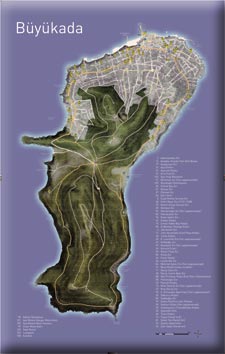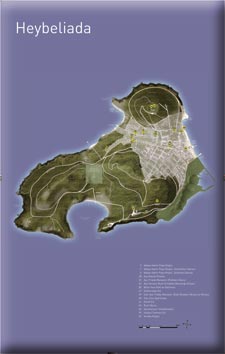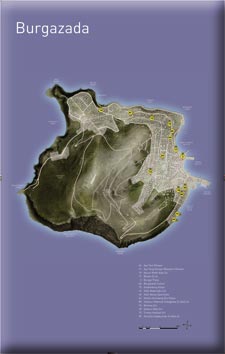Heybeliada - Halki
Heybeliada - Center
- Details
- Created on 18 February 2013
- Last Updated on 11 April 2013
Village Center
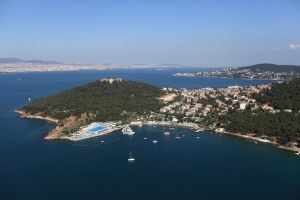 As the visitor approaches the island by ferry he can observe the Greek Orthodox seminary dominating its hill, the Halki Palas Hotel, the former Greek Commercial School (now part of the Naval High School), and the old windmill topping Değirmen Tepesi, above the Water Sports Club.
As the visitor approaches the island by ferry he can observe the Greek Orthodox seminary dominating its hill, the Halki Palas Hotel, the former Greek Commercial School (now part of the Naval High School), and the old windmill topping Değirmen Tepesi, above the Water Sports Club.
The focal point of the village is the ferry landing on the east coast, with the iskele for the sea bus a short distance to its north. The shore road betwen the two iskeles is lined with cafes and restaurants. The principal market street runs parallel to the shore road one short block in from the sea. On the southeastern promontory of the island, next to the ferry landing, is the Deniz Lisesi or Naval High School, with its twin-towered main building and miniature port, and just north of the iskeles is a little fishing port, in which fishing boats and pleasure craft are anchored.
The Greek Orthodox Church of St. Nicholas
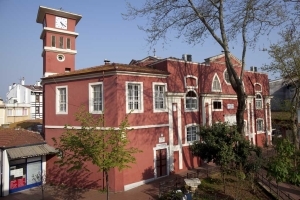 The Greek Orthodox church of St. Nicholas (Hagios Nikolaos) dominates the main square of the village, two short blocks in from the sea bus iskele. It was erected in 1857 on the ruins of a Byzantine church dedicated to St. Nicholas, the patron saint of mariners, appropriate for an island where virtually all of the men were seafarers and fishermen. The architect was Hacı Stefani Gaytanki Kalfa. The church was damaged in the 1894 earthquake, but it was soon afterwards repaired. It is cruciform in plan, with a dome on a high drum covering the central area, supported by four piers, and with barrel vaults over the four arms, a lofty clock-tower campanile rising separately from the main structure. Behind the altar is the tomb of Patriarch Samuel I, who died in 1775. A separate building in front of the narthex houses the hagiasma, or sacred spring, of St. Paraskevi (Hagia Paraskevi).
The Greek Orthodox church of St. Nicholas (Hagios Nikolaos) dominates the main square of the village, two short blocks in from the sea bus iskele. It was erected in 1857 on the ruins of a Byzantine church dedicated to St. Nicholas, the patron saint of mariners, appropriate for an island where virtually all of the men were seafarers and fishermen. The architect was Hacı Stefani Gaytanki Kalfa. The church was damaged in the 1894 earthquake, but it was soon afterwards repaired. It is cruciform in plan, with a dome on a high drum covering the central area, supported by four piers, and with barrel vaults over the four arms, a lofty clock-tower campanile rising separately from the main structure. Behind the altar is the tomb of Patriarch Samuel I, who died in 1775. A separate building in front of the narthex houses the hagiasma, or sacred spring, of St. Paraskevi (Hagia Paraskevi).
Heybeliada - Tour Trough the Woods, Monasteries and Çam Limanı
- Details
- Created on 11 April 2013
- Last Updated on 11 April 2013
Monastery of Hagia Triada
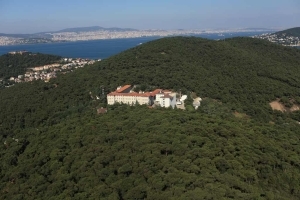 In Byzantine times, there were at least three monasteries on Heybeliada, then known as Halki. The most renowned of these was Hagia Triada, the Holy Trinity, whose site on Ümit Tepesi is occupied by the Greek Orthodox theological school of the same name, a direct descendant of the original Byzantine monastery. The present monastery is the most prominent monument on Heybeliada, dominating the view from an approaching ferry and from within the village itself.
In Byzantine times, there were at least three monasteries on Heybeliada, then known as Halki. The most renowned of these was Hagia Triada, the Holy Trinity, whose site on Ümit Tepesi is occupied by the Greek Orthodox theological school of the same name, a direct descendant of the original Byzantine monastery. The present monastery is the most prominent monument on Heybeliada, dominating the view from an approaching ferry and from within the village itself.
The earliest reference to a monastery on Halki is in the writings of St. Theodore of Studius early in the ninth century. Theodore, abbot of Constantinople’s famous monastery of St. John of Studius, was exiled to a monastery on Halki by Leo V (r. 813-20) because of his criticism of the emperor’s iconoclastic policy. While on Halki, Theodore wrote a number of letters, theological treatises, and poems, one of which was addressed fondly to the monastic cell in which he was confined.
The monastery of the Holy Trinity was restored by the patriarch Photius I (r. 858-67, 877-86), who was twice exiled there, first between his two terms as patriarch and then in the years 887-90. Photius died in the monastery in 890 and was buried there; he was subsequently canonized and is today revered as the patron saint of the Theological School of the Holy Trinity.
The monastery was apparently destroyed at the time of the Turkish Conquest in 1453, moving one anonymous chronicler to lament the loss of what "had earlier been a place where wisdom and knowledge were studied, not only by monks but also by kings and noblemen." In 1550 the monastery was rebuilt or at least partially restored by the future patriarch Metrophanes III (r. 1565-72, 1579-80). Metrophanes also gave to the monastery some three hundred manuscripts, a priceless gift that formed the nucleus of what was to become one of the most renowned libraries in the Orthodox world after that of the Patriarchate in Istanbul.
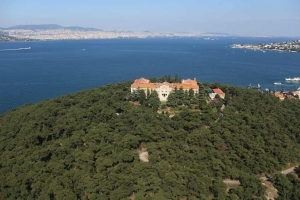 Hagia Triada went through difficult times in the seventeenth and eighteenth centuries, but its finances, at least, improved after Peter the Great, Tsar of Russia (r. 1682-1725), issued a chrysobull giving the monastery a long-term endowment. The monastery was rebuilt and refurbished in 1773 through the efforts of its energetic abbot, Samuel the Deaf. The monastery was badly damaged in 1821, at the beginning of the Greek War of Independence, when it was attacked by a mob and set on fire. The monastery was rebuilt in 1844 by Patriarch Germanos IV, who decreed in a synod that "a theological school should be built for a purpose pleasing to God and dwelt in by theology teachers, priests who wish to learn, and future priests." Wooden buildings were erected to house the classrooms, study hall, teachers’ quarters, student dormitories, refectory, infirmary, and patriarchal apartments, while a two-storey stone structure was built for the library. Then in 1891 a three-storey wing was added to house the administrative offices and new dormitories. All of these structures were seriously damaged in the great earthquake of 1894. Thus a completely new building had to be erected for the monastery, all of the funds for which were provided by the philanthropist Pavlos Skylitsis Stephanovik. The new monastery was designed by the architect Pericles Photiades, and the building was officially dedicated on 6 October 1896, the archimandrite Germanos Gregoras presiding as Rector of the Theological School.
Hagia Triada went through difficult times in the seventeenth and eighteenth centuries, but its finances, at least, improved after Peter the Great, Tsar of Russia (r. 1682-1725), issued a chrysobull giving the monastery a long-term endowment. The monastery was rebuilt and refurbished in 1773 through the efforts of its energetic abbot, Samuel the Deaf. The monastery was badly damaged in 1821, at the beginning of the Greek War of Independence, when it was attacked by a mob and set on fire. The monastery was rebuilt in 1844 by Patriarch Germanos IV, who decreed in a synod that "a theological school should be built for a purpose pleasing to God and dwelt in by theology teachers, priests who wish to learn, and future priests." Wooden buildings were erected to house the classrooms, study hall, teachers’ quarters, student dormitories, refectory, infirmary, and patriarchal apartments, while a two-storey stone structure was built for the library. Then in 1891 a three-storey wing was added to house the administrative offices and new dormitories. All of these structures were seriously damaged in the great earthquake of 1894. Thus a completely new building had to be erected for the monastery, all of the funds for which were provided by the philanthropist Pavlos Skylitsis Stephanovik. The new monastery was designed by the architect Pericles Photiades, and the building was officially dedicated on 6 October 1896, the archimandrite Germanos Gregoras presiding as Rector of the Theological School.
Read more: Heybeliada - Tour Trough the Woods, Monasteries and Çam Limanı


